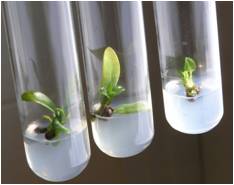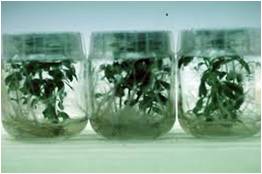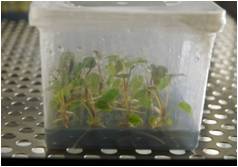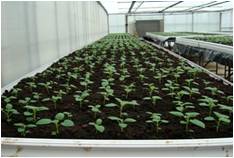
|
|
| Home | About Forestry | Eco-Tourism | Forestry Addresses | FAQs | Contact Us | |
|
| Clonal Forestry | |
TISSUE CULTURE TECHNIQUES FOR TREE SPECIES |
|
Stages involved in Micropropagation : The sequential stages recognized in any micropropagation systems involved are (i) establishment, (ii) multiplication, (iii) pre-transplant and (iv) transplantion. The medium used for micropropagation has two major functions, a) to supply basic ingredients for continued growth of the isolated explant and subsequent propagation and (b) to direct growth and development through hormonal control viz., auxins, cytokinins, gibberellins and abscisic acid. The hormonal control exercised by (i) kind of hormone or growth regulator, (ii) its concentration, and (iii) sequence in which they are applied. |
|
a) Establishment Stage The factors that affect establishment stage are (i) choice of explant, (ii) elimination of contamination of the explant, and (iii) culture conditions. In general younger tissue such as shoot tips or terminal buds will regenerate better than older and mature tissues of the same stem. In general, ingredients of the culture medium in the first stage are determined by kind of response needed. The culture room conditions involve a temperature range of 25 ± 2º C and with a photoperiod of 16 hrs. light and 8 hrs. darkness. This stage lasts for 4 to 8 weeks which depends on species. |
 |
b) Multiplication Stage The function of this stage is to increase the number of propagules for later rooting to planting stage. The propagules are cut and separated to be grown into plantlets in a new medium. Number of multiplications may vary from 5 to 50 depending on species and method. Generally cytokinins are used for multiplication of shoots. |
 |
c) Pre-Transplant Stage The function of this stage is to prepare the plantlet for transplanting and establishment outside the artificial, closed or open environment. In this stage, prolific root initiation is the main objective. This is achieved by reducing cytokinin concentration, and increasing auxin supplies. Other conditions required are reduction in inorganic salt concentration and addition of pholoroglucinol to improve rooting and to reduce callusing. |
 |
d) Transplant Stage This stage involves the transfer of the plantlet from the aseptic cultural environment to the free living environment of the green house and ultimately required hardening process to the final field location. The plantlet must not only root adequately but also must undergo a period of acclamation to enable it to survive and establishment. |
 |
| Home | About Forestry | Eco-Tourism | Forestry Addresses | FAQs | Contact Us | |
|
| © All Rights Reserved. TNAU-2016. |
|